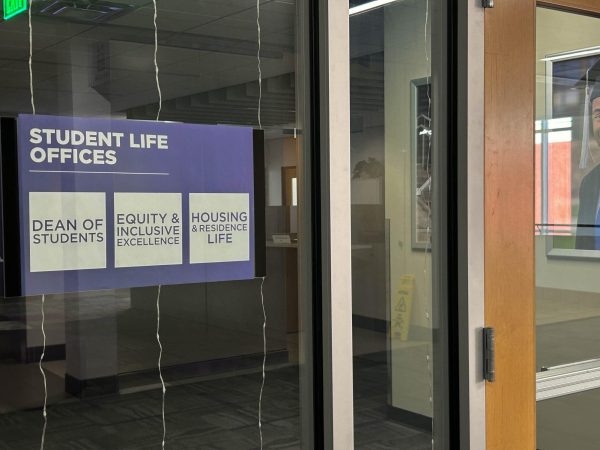Ellinghuysen annouces $6 million budget reduction

March 4, 2020
Winona State University’s chief financial advisor Scott Ellinghuysen announced a $6 million budget reduction plan to combat the school’s budget deficit.
Ellinghuysen sent out a “university budget update” e-mail to Winona State employees on Feb. 17 to make the announcement.
Back in September and October, Ellinghuysen informed employees and students that the university was in a $1.6 million budget deficit.
The school had made budget reduction plans for either $3, $4 or $5 million for fiscal year 2021 depending on future enrollment numbers and other various factors.
Ellinghuysen said in the beginning of February that the school had been moving towards its $5 million budget reduction plan for the 2021 school year.
However, the most recent e-mail update revealed a fourth budget reduction plan of $6 million has been put into place.
The e-mail said that although the university is seeing “positive trends” in transfer student and graduate student applications, it is currently down 12% in incoming freshman applications compared to last year.
“We need to be prepared for the worst and hope for the best,” said Denise McDowell, vice president of Enrollment and Student Life.
Around this time last year, Winona State had over 7,000 incoming freshmen applications.
This year, there have only been around 6,400 applications so far, creating the 12% decline.
However, transfer student numbers are increasing, and the accepted graduate student application rate is up over 700%.
Around this time last year, there had only been 18 accepted graduate students versus the 147 accepted students this year.
McDowell said that the decision to implement the $6 million budget reduction target was due to numerous factors.
Factors included general decline in high school graduation rates and therefore lower application numbers, the chance Winona State will receive little supplemental funding and could be denied its proposed 3% tuition increase.
“We’re trying to be more proactive,” McDowell said. “This is the just-in-case. It’s one of those heart-wrenching opportunities.”
McDowell also said she believes it is “inevitable” that tuition rates will rise again unless more support is given to universities from the government.
“Universities are going to have to decide what programs and services are must-haves and what are nice-to-have’s,” McDowell said.
McDowell also said that as vice president of student life, her and her team have made it their mission to try and minimize negative impact on students.
She is working on preserving work study positions and hours for students and protecting other recreational activities, like Kryzsko After Dark.
“We have to attract students who are cutting edge, who want to be the leaders of the future,” said McDowell. “We have to decide, ‘what are our priorities’ and ‘how do we create this advanced learning environment?’”
Alongside its additional funding request from the state legislature and a proposed 3% increase in tuition, Winona State also recently implemented Board Early Separation Incentive (BESI).
BESI was implemented in hopes that faculty members would enter early retirement with monetary incentive.
Ellinghuysen had said in October that “our [Winona State’s] biggest expense is people.”
This is something the university seems to be trying to cut back on.
BESI was delivered to specific departments and only to those who are 55 years or older with ten consecutive semesters or five continuous years of employment with Minnesota State Universities.
Areas targeted were the colleges of Business, Education, Liberal Arts, Nursing and Health Sciences and Science and Engineering.
Those eligible in the library, business office, campus card/purple pass area and Information Technology also received the offer.
The president’s office, administration and athletic departments were among those not targeted for BESI.
“Administrators were asked to identify the departments where we could either absorb the retirement without replacement,” Ellinghuysen said in the e-mail announcement. “Or the replacement would yield substantial salary savings.”
Those who accept BESI by its deadline of March 16 will either retire this year or next and may not be replaced.
The university will not know how much money it will save by using BESI until its deadline and will not know if an increase in tuition has been approved by legislature until May or June, according to McDowell.
“That’s a whole lot of ‘maybes’,” McDowell said. “So, if you don’t know, then plan for the extreme and hope for the best.”
However, Winona State is not in a unique financial situation.
Several other Minnesota State universities and colleges have reported to be struggling with enrollment numbers and finances.
McDowell said that even though Winona State is going through a budget deficit and will likely raise its tuition rates for another consecutive year, it is still able to boast affordability compared to competing area universities.
“We provide that private school-feel at a public-school price,” McDowell said. “It is not like the others around us are staying stable, so we still fall in the middle of the pack.”
The university is still planning on expanding and offering new amenities to students, including a possible e-sports lounge, McDowell said.
Winona State administration is planning to have another budget meeting at the end of March to discuss updates.
Further budget updates will be given through a public budget forum in April, according to Ellinghuysen.
The opinions expressed in this paper are not necessarily those of Winona State University, the Minnesota State Colleges and University system, or the Winona State University student body.





































































